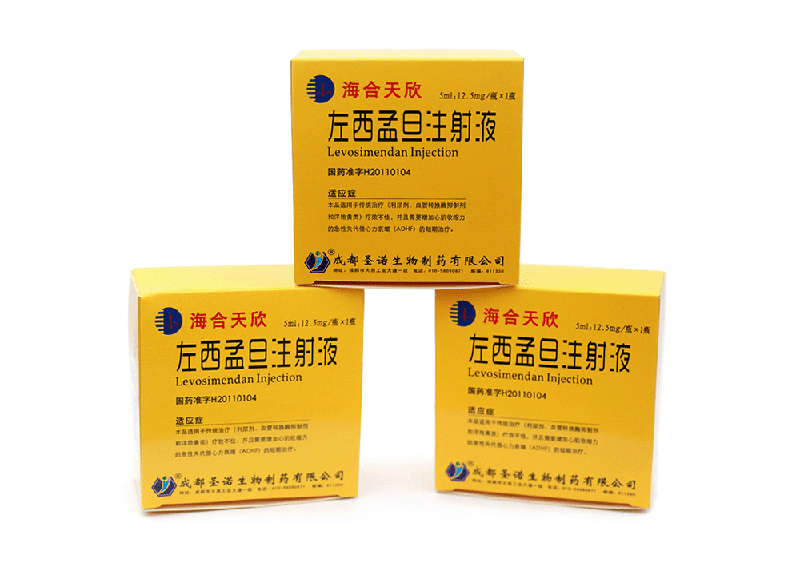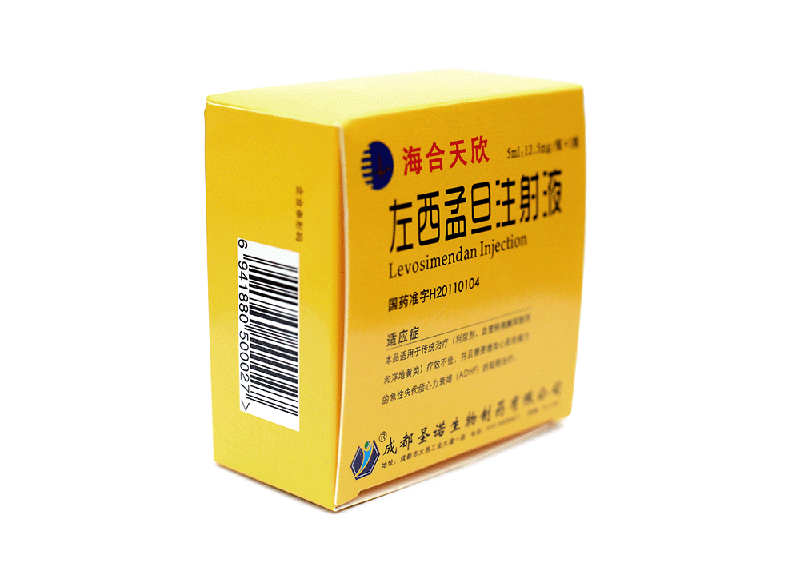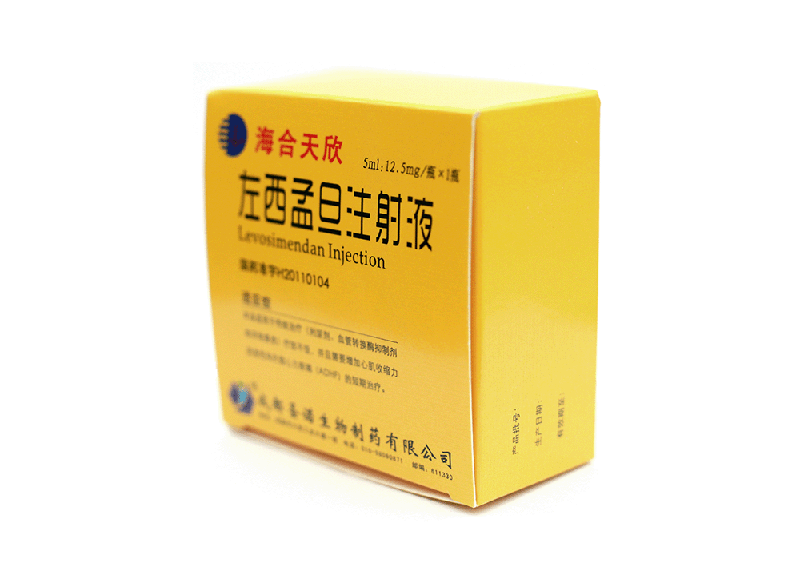


Levosimendan injection
[drug name] general name: Levosimendan injection English Name: Levosimendan injection Chinese Pinyin: zuoximengdan Zhusheye
[ingredients] main ingredients: Chemical Name: molecular formula: molecular weight: auxiliary materials:
[properties] the product is a clear liquid from yellow green to orange yellow, and the color becomes darker when it is heated.
[indications] this product is suitable for the short-term treatment of acute decompensated heart failure (ADHF), which is not effective in traditional treatment (diuretics, inhibitors of vascular converting enzyme and digitalis), and needs to increase myocardial contractility.
Related information
[usage and dosage] this product is only used for inpatients, and should have suitable medical monitoring equipment and experience in using positive inotropic drugs.
This product needs to be diluted before administration. This product is only used for intravenous infusion and can be administered through peripheral or central vein. The dosage and duration of treatment should be adjusted according to the general situation and clinical manifestations of patients.
The initial load dose of the treatment is 6-12 μ g / kg, the time should be more than 10 minutes, and then continuous infusion of 0.1 μ g / kg / min (see Table 1 and table 2). For patients with vasodilators or / and positive inotropic drugs, the recommended loading dose at the beginning of treatment is 6 μ g / kg. High loading dose can produce strong hemodynamic effect and may lead to a short-term increase in the incidence of adverse reactions.
At the time of loading dose administration and within 30-60min from the beginning of continuous administration, observe the patient's reaction closely, such as overreaction (hypotension, tachycardia), reduce the infusion rate to 0.05 μ g / kg / min or stop the administration. If the initial dose tolerance is good and the hemodynamic effect needs to be enhanced, the infusion rate can be increased to 0.2 μ g / kg / min. For patients with severe chronic heart failure in the acute decompensated period, the continuous administration time is usually 24 hours.
No drug resistance and rebound were found after levosimendan was stopped. The hemodynamic effect can last for at least 24 hours, and may last for 9 days after discontinuation. The experience of reusing zuoximendan is limited. The experience of other vasodilators such as myocardial contractile agents (except for * * *) is also limited. The combination of vasodilators and vasoactive drugs requires a lower loading dose (6 μ g / kg).
Before use, observe whether the diluent contains particulate impurities and discoloration. The diluted levosimendan was infused separately. It should be used within 24 hours after infusion preparation. Preparation method of 0.025mg/ml infusion: mix 5ml levosimendan injection with 500ml 5% glucose injection; preparation method of 0.05mg/ml infusion: mix 10ml levosimendan injection with 500ml 5% glucose injection.
Monitoring of treatment: ECG, blood pressure and heart rate must be monitored and urine volume measured during the treatment. The monitoring of these parameters should last at least 3 days after the infusion or until the patient's clinical symptoms are stable.
It is recommended to monitor at least 5 days for patients with mild or moderate renal damage or liver damage. Patients with renal function impairment: Patients with mild or moderate renal function impairment should use this product carefully, and patients with severe renal function impairment (creatinine clearance rate < 30ml / min) should be prohibited.
Patients with liver function damage: Patients with mild or moderate liver function damage should use this product carefully, but do not need to adjust the dosage. Patients with serious liver function damage should not use it. The following drugs can be used simultaneously with levosimendan: furosemide (diuretic) 10mg / ml * * * (cardiotonic) 0.25mg/ml nitroglycerin (prevention and treatment of angina pectoris) 0.1mg/ml
[adverse reactions] the most common adverse reactions in clinic are headache, hypotension and ventricular tachycardia. The common adverse reactions are hypokalemia, insomnia, dizziness, tachycardia, ventricular premature beat, heart failure, myocardial ischemia, premature beat, nausea, constipation, diarrhea, vomiting, and decrease of blood red protein. See the table below for details. (the form is not printed out)
[taboo]
-
Patients who are allergic to levosimendan or any other excipients;
-
Mechanical occlusive diseases that significantly affect ventricular filling or / and ejection function;
-
Patients with severe liver and kidney (creatinine clearance rate < 30ml / min) functional damage;
-
Patients with severe hypotension and tachycardia;
-
Patients with a history of torsade de pointe (TDP).
[precautions]
-
The hemodynamic effect of levosimendan in the early stage may cause the decrease of systolic and diastolic blood pressure. Therefore, for patients with low basic systolic or diastolic blood pressure, or patients at risk of hypotension, it is recommended to use a more conservative dose range, and adjust the dose and time according to the patients' own conditions and reactions.
-
Levosimendan should be corrected for severe hypovolemia before administration. If there is excessive change in blood pressure or heart rate, the infusion rate should be reduced or stopped.
-
The exact duration of hemodynamic effect of this product has not been determined, generally lasting for 7-10 days. Part of this was due to the presence of active metabolites, which reached the maximum blood concentration 48 hours after the infusion was stopped. After infusion, noninvasive monitoring should last for at least 4-5 days, and the monitoring should continue until blood pressure drops to the lowest value and starts to rise. If there is a continuous drop in blood pressure, it needs to be monitored for more than 5 days. If the patient's clinical symptoms are stable, the monitoring period can be less than 5 days. Patients with mild to moderate renal and liver damage need to extend the monitoring period.
-
Due to the limited data on the elimination of active metabolites in patients with renal function injury, levosimendan should be especially cautious when used in patients with mild or moderate renal function injury. Renal function injury may lead to an increase in the concentration of active metabolites, resulting in a more obvious and lasting hemodynamic effect. It is forbidden to use this product in patients with severe renal function injury (creatinine clearance rate < 30ml / min). Special care should be taken in patients with mild to moderate liver damage, which may lead to prolonged exposure of active metabolites, resulting in more significant and lasting hemodynamic effects. It is forbidden to use this product in patients with severe liver function injury.
-
This product may cause the decrease of blood potassium concentration. Therefore, the abnormal blood potassium concentration of patients should be corrected before medication and the blood potassium concentration should be monitored during the treatment. When it is used together with other heart failure drugs, levosimendan infusion may reduce hemoglobin and hematocrit, so patients with ischemic heart disease and anemia should use it carefully.
-
Patients with tachycardia, atrial fibrillation, or fatal arrhythmia should use this product with caution.
-
The experience of repeated use of this product is limited; the experience of levosimendan in combination with other cardiovascular active drugs, including vasoconstrictors (* *) is limited. The medication plan should be determined after the benefit risk assessment of patients.
-
For patients with coronary artery ischemia, long QTc interval for any reason, or those who use drugs for prolonging QTc interval at the same time, the product should be used with caution, and ECG monitoring should be carried out.
-
Levosimendan has not been used in cardiogenic shock. There is no information on the use of this product in patients with restrictive cardiomyopathy, hypertrophic cardiomyopathy, severe mitral insufficiency, myocardial rupture, cardiac tamponade, right ventricular infarction, and potentially fatal arrhythmias within 3 months.
-
This product cannot be used in children because of the limited experience for children and adolescents under 18 years old.
-
This product has less experience in patients with postoperative heart failure and severe heart failure to be transplanted. [medication for pregnant women and lactating women] no experience of levosimendan for pregnant women. As animal tests show that zuoximendan is toxic to the foetal formation period, pregnant women should weigh the advantages and disadvantages before using it; at present, it is not known whether zuoximendan is excreted in breast milk, so lactating women can not breast-feeding within 14 days after zuoximendan infusion.
[children's medication] zuoximendan cannot be used in children or adolescents under 18 years old.
[geriatric medication] it is used by elderly patients without adjusting the dosage.
[drug interaction] as levosimendan may cause hypotension, we should be careful when infusing it with other vasoactive drugs at the same time. No pharmacokinetic interaction was found in patients who received levosimendan and * * * at the same time. It does not affect the efficacy of β - blocker. The response of postural hypotension in healthy volunteers to levosimendan and isosorbide mononitrate was significantly increased.
[overdose] excessive use of levosimendan can cause hypotension and tachycardia. It has been reported that hypotension caused by levosimendan can be treated with pressor drugs (such as dopamine in patients with congestive heart failure and adrenaline in patients after cardiac surgery). High dose (≥ 0.4 μ g / kg / min) and infusion for more than 24 hours can accelerate heart rate and sometimes extend QTc interval
If the heart filling pressure is excessively decreased, the patient's response to this product may be reduced. It can be treated by intravenous rehydration. In case of levosimendan overdose, ECG (electrocardiogram) should be monitored continuously, serum electrolyte should be monitored repeatedly, and invasive hemodynamic monitoring should be used.
Levosimendan overdose will lead to an increase in the concentration of active metabolites in the plasma, which may have a more significant effect on the heart rate and a longer duration, so the monitoring period needs to be prolonged accordingly.
[pharmacology and toxicology]
Mechanism of use: This product is a calcium sensitizer, which combines with cardiac troponin C in a calcium ion concentration dependent manner to produce positive inotropic effect and enhance cardiac contractility, but does not affect ventricular diastole; at the same time, this product can produce vasodilation by opening ATP sensitive K + channel (KATP), and use coronary resistance vessel and vein volume vessel diastole, so as to improve crown In addition, it can inhibit phosphodiesterase Ⅲ. In patients with heart failure, the positive inotropic and vasodilative effects of levosimendan can increase the contractile force and reduce the load before and after, without affecting the diastolic function.
Acute toxicity: LD50 of levosimendan was 152mg / kg ~ 156mg / kg, and LD50 of intravenous injection (i.v.) was 32mg / kg ~ 50mg / kg. The LD50 of P.O. and i.v. levosimendan were 103mg / kg and 57mg / kg, respectively. The acute toxic phenomena of this medicine are: hypokinesia, bristle, shortness of breath, salivation, ataxia, paresis and collapse of hind limbs. The cause of death was cardiac arrest. The ED50 of levosimendan was 0.03mg/kg. So the treatment index (LD50 / ED50) in rats was about 1900.
Long term toxicity:
-
Rats: Levosimendan was given intravenously (0.25,2.5,25mg / kg / day) or orally (1,7,50mg / kg / day) for 4 or 13 weeks. The peak plasma concentration of levosimendan was 250 and 400 times higher than that of levosimendan in clinical treatment. There were no drug-related deaths. There was no change in the appearance and activity of the rats.
-
Dogs: Beagle dogs were injected (0.27,0.60 or 2.22mg / kg / day) or orally (1,7,50mg / kg / day) levosimendan for 4 or 13 weeks. The mean plasma concentration of levosimendan was in the range of 300-4500ng / ml. There were no deaths in each group. The long-term treatment with levosimendan is well tolerated and has little side effects in dogs. Teratogenesis and mutation: Ames test showed that zuoximendan had no mutagenicity. There was no teratogenicity and embryotoxicity of levosimendan during organogenesis in rats and rabbits. Zuoximendan had no adverse effect on the reproductive ability of male rats. Long term use of levosimendan will have a dose-dependent adverse effect on the formation and maintenance of pregnancy. The use of levosimendan did not cause any damage to the surviving offspring in the womb.
[pharmacokinetics] General pharmacokinetics the pharmacokinetics of levosimendan is linear in the dose range of clinical treatment (0.05-0.2 μ g / kg / min). Distribution: the VSS of levosimendan is about 0.2l/kg. 97-98% of levosimendan binds to plasma protein, mainly albumin. The binding rate of the active metabolite OR-1896 was 40%. Metabolism: Levosimendan can be completely metabolized, and the amount of drugs excreted in prototype form from urine and feces is negligible.
It is mainly metabolized by combining with cyclized or N-acetylated cysteine and cysteine. About 5% of them were reduced to aminopyridazinone (or-1855) in the intestine, which was metabolized to active metabolite OR-1896 by N-acetyltransferase after reabsorption. The level of acetylation is determined by heredity. The concentration of the active metabolite OR-1896 in the fast acetylated group was slightly higher than that in the slow acetylated group, but it had no effect on the clinical efficacy of the recommended dose range.
In vitro studies showed that levosimendan had moderate CYP2D6 inhibition, but its metabolites had no inhibition on CYP1A1, CYP1A2, CYP2A6, CYP2C9, CYP2C19, CYP2E1 and CYP3A4 at the recommended dosage. Excretion: the clearance rate was 3.0ml/min/kg, and the half-life was about 1 hour. 54% were excreted from urine, 44% from feces, and more than 95% of drugs could be excreted within one week. The metabolites of the formed cycle are or-1855 and OR-1896, which excrete slowly. The peak plasma concentration was reached about 2 days after the discontinuation of levosimendan injection. The half-life of metabolites is about 75-80 hours. The exclusion of the active metabolite OR-1896 has not been fully determined.
Children in special population: limited data show that the pharmacokinetics of levosimendan in single use for children (3 months to 6 years old) is similar to that of adults. No active metabolites have been studied in children. Patients with renal function impairment: the pharmacokinetics of levosimendan in patients with mild to moderate renal function impairment was similar to that in healthy people. There was no definite effect of dialysis on the pharmacokinetics of levosimendan. The pharmacokinetic data of active metabolites are limited in patients with renal impairment.
Patients with liver function injury: the excretion of levosimendan in patients with mild liver function injury was slightly reduced. There was no study on the pharmacokinetics of levosimendan in patients with moderate or severe liver function injury. There is no pharmacokinetic study on active metabolites in patients with liver function injury. Age, race and gender had no effect on the pharmacokinetics of levosimendan. However, the distribution and clearance of levosimendan were related to body weight.
[storage] it is dark, airtight and stored at 2-8 ℃.
[package] antibiotic glass bottle + butyl rubber stopper package, 1 piece / box.
[validity period] 24 months.
[approval No.] gyzz h20110104 [manufacturer] Chengdu shengnuo biopharmaceutical Co., Ltd
Chengdu Shengnuo Biotechnology Co.
Tel: 86-28-88203630
Fax: 86-28-88203630
Email: roleagh@gmail.com
QQ:2539328606
Facebook:[LEI LI](https://www.facebook.com/profile.php? id=100047326162701)
Linkedin: Roleagh
Chengdu Shengnuo Biotechnology Co., Ltd. has "Chengdu polypeptide drug engineering technology research center" in Chengdu, mainly engaged in polypeptide, polypeptide drug and beauty peptide research. Our zero defect has passed the FDA certification, and now it has become the first-class professional peptide drug and product development, technology transfer, technical service and peptide drug industry in the scale production and export of China's parks.